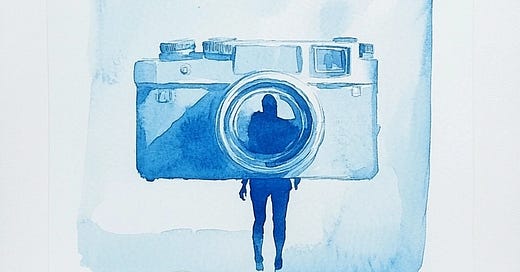Capture Nothing, Reveal Everything
Imagine a camera that captures nothing. No image, no frozen memory. Just a ritual. This object exists: the LEGO Polaroid. Launched in January, it offers nothing but the gesture itself.
A gimmick? Hardly. It’s a lesson.
We live in an age of fleeting snapshots—memories consumed before they’re even lived. Images without stories, proof without permanence. A relentless stream of moments that vanish as quickly as they’re captured. In this world where we seek to immortalize everything without ever knowing what to hold onto, this Polaroid invites us to reflect.
It celebrates the act of photography without the need to possess. To raise the camera, to frame the moment… and to let it go.
Breaking Free from Nowstalgia
This paradox resonates deeply in our time, where images reign supreme. Flashback, a project launched on Kickstarter, takes this reflection further. No screens, no filters: you capture the moment, then you wait. The image only appears 24 hours later, giving you the time to truly live the moment. It’s a way of reconnecting with authenticity in an age of “everything, right now.”
This quest also addresses a very contemporary phenomenon: nowstalgia. We strive to preserve the present at all costs, but in this obsession, we miss the essence of it. By framing and filming, we’re already living in the nostalgia of a moment we haven’t taken the time to feel.
Both Flashback and the LEGO Polaroid invite us to pause. To let go of the compulsion to record everything and instead embrace the experience of the moment.
Perfectly Imperfect
In this spirit, Nonna’s Cam, created by the imaginative minds at LOLA MullenLowe Madrid, goes beyond the simple act of taking pictures. Featuring a hyper-realistic finger placed in front of the lens, this analog camera humorously and affectionately captures the endearing clumsiness of our grandparents. Every partially obscured photo becomes a tender tribute to cherished memories.
This project invites us to slow down and rethink our obsession with technical perfection, so often sought through our smartphones, and rediscover the beauty of imperfection. After all, isn’t the true value of an image found more in the emotions it evokes than in its flawless precision?
When Reality Wavers
This pursuit of authenticity leads to a deeper question: how do we relate to reality? In a world where deepfakes, filters, and virtual realities blur the lines between truth and illusion, can we still trust images? Can we tell what’s real from what’s fake?
The concept of the liar’s dividend—the notion that doubt benefits those who distort the truth—makes this even more challenging. When everything seems falsifiable, even the genuine can be dismissed with a simple, “Maybe it’s fake.”
Amid this rising skepticism, new solutions are emerging. The ROC camera, for instance, promises “authentic moments.” By combining sensors, on-device client-side zero-knowledge proofs, and a tamper-proof TEE environment for attesting sensor data, it guarantees the integrity of its images, aiming to restore trust in what we see.
But this pursuit of certainty comes with its own paradox: when a photograph becomes too verifiable, does it lose its magic?
Nietzsche captured the idea best: absolute truths confine the mind, whereas uncertainty sets it free. By making ideas irrefutable, do we risk sacrificing that poetic blur—the touch of mystery that turns the ordinary into the extraordinary?
Reinventing Photography
The evolution of photography doesn't stop here. New concepts are pushing the boundaries of imagination and redefining our relationship with the moment.
Take Soft, for example, an app that captures the rhythm of your environment to transform each photo into a living work of art. Colors, saturation, grain—every aspect of an image is shaped by the surrounding atmosphere, embedding the very breath of the moment into the frame. Here, the goal is no longer to faithfully reproduce a scene, but to capture the essence of everything around it.
Others venture into more mysterious realms, like Paragraphica, a singular device without a lens or sensor. Guided by AI, it captures the whispers of places through their invisible data, translating them into words, then into images, unveiling the hidden secrets of reality. Or DreamGenerator, which blends classic photography with creative prompts, transforming a simple snapshot into a magical or retro scene shaped by the user’s imagination.
In an even more symbolic gesture, the Poetry Camera ventures into a different realm: instead of capturing a photo, it offers a poem. It’s a way to embrace the moment on a deeper level, adding layers of meaning that unfold slowly, like a memory revealing itself over time. A beautiful metaphor, isn’t it?
Photographing the Soul
What should we take away from all this? The evolution of photography, from the first daguerreotypes to these cameras that rewrite reality, seems to tell us of an unending quest: the desire to capture not only the moment but also the essence it holds. Its power lies in suggesting more than it shows, leaving room for imagination and mystery.

After Impressionism, Expressionism, and Surrealism, we enter the era of Selfpressionism—a shift from depicting the visible world to delving into our inner experience. Devices like the Poetry Camera and the DreamGenerator go beyond their original purpose: they don’t merely freeze what is seen; they invite us to inhabit the moment in entirely new ways. These tools, standing at the intersection of ritual and reflection, encourage us to uncover unexpected depths in the fleeting nature of life.
There are photos that take everything. And there are those that leave everything—the silence, the breath, the fleeting glow of a moment. A memory without an image, yet a light that lingers.
Photography is not a cage for time; it is a key. A key that sets the moment free, letting it vibrate and resonate. So next time you frame a moment, ask yourself: will you capture the visible… or liberate the invisible?
MD








